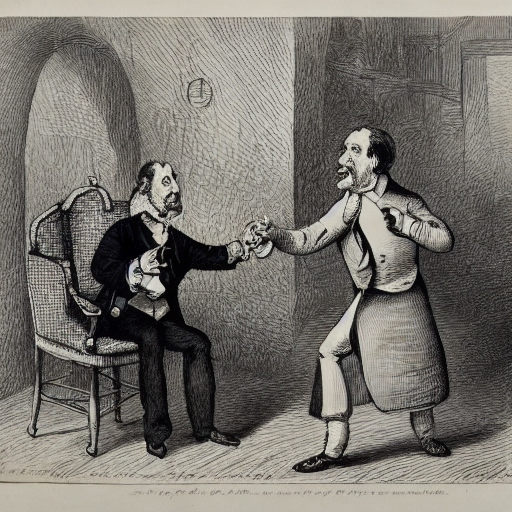No less than seven little men and women in night-caps, in frocks, in bibs, in breeches, are clambering about the head, knees, and arms of the man with the nose; their noses, too, are preternaturally developed -- the twins in the cradle have noses of the most considerable kind; the second daughter, who is watching them; the youngest but two, who sits squalling in a certain wicker chair; the eldest son, who is yawning; the eldest daughter, who is preparing with the gravy of two mutton chops a savory dish of Yorkshire pudding for eighteen persons; the youths who are examining her operations (one a literary gentleman, in a remarkably neat night-cap and pinafore, who has just had his finger in the pudding); the genius who is at work on the slate, and the two honest lads who are hugging the good-humoured washerwoman, their mother, -- all, all, save this worthy woman, have noses of the largest size. Not handsome certainly are they, and yet everybody must be charmed with the picture. It is full of grotesque beauty. The artist has at the back of his own skull, we are certain, a huge bump of philoprogenitiveness. He loves children in his heart; every one of those he has drawn is perfectly happy, and jovial, and affectionate, and innocent as possible. He makes them with large noses, but he loves them, and you always find something kind in the midst of his humour, and the ugliness redeemed by a sly touch of beauty. The smiling mother reconciles one with all the hideous family: they have all something of the mother in them -- something kind, and generous, and tender.

Knight's, in Sweeting's alley; Fairburn's, in a court off Ludgate hill; Hone's, in Fleet street -- bright, enchanted palaces, which George Cruikshank used to people with grinning, fantastical imps, and merry, harmless sprites, -- where are they ? Fair- burn's shop knows him no more; not only has Knight disappeared from Sweeting's alley, but, as we are given to understand, Sweeting's alley has disappeared from the face of the globe -- Slop, the atrocious Castlereagh, the sainted Caroline (in a tight pelisse, with feathers in her head), the " Dandy of sixty," who used to glance at us from Hone's friendly windows -- where are they? Mr Cruikshank may have drawn a thousand better things, since the days when these were; but they are to us a thousand times more pleasing than anything else he has done. How we used to believe in them ? to stray miles out of the way on holidays, in order to ponder for an hour before that delightful window in Sweeting's alley! in 'walks through Fleet street, to vanish abruptly down Fairburn's passage, and there make one at his " charming gratis " exhibition. There used to be a crowd round the window








